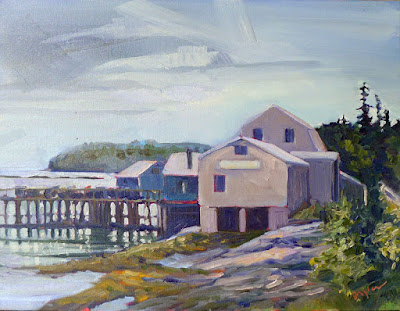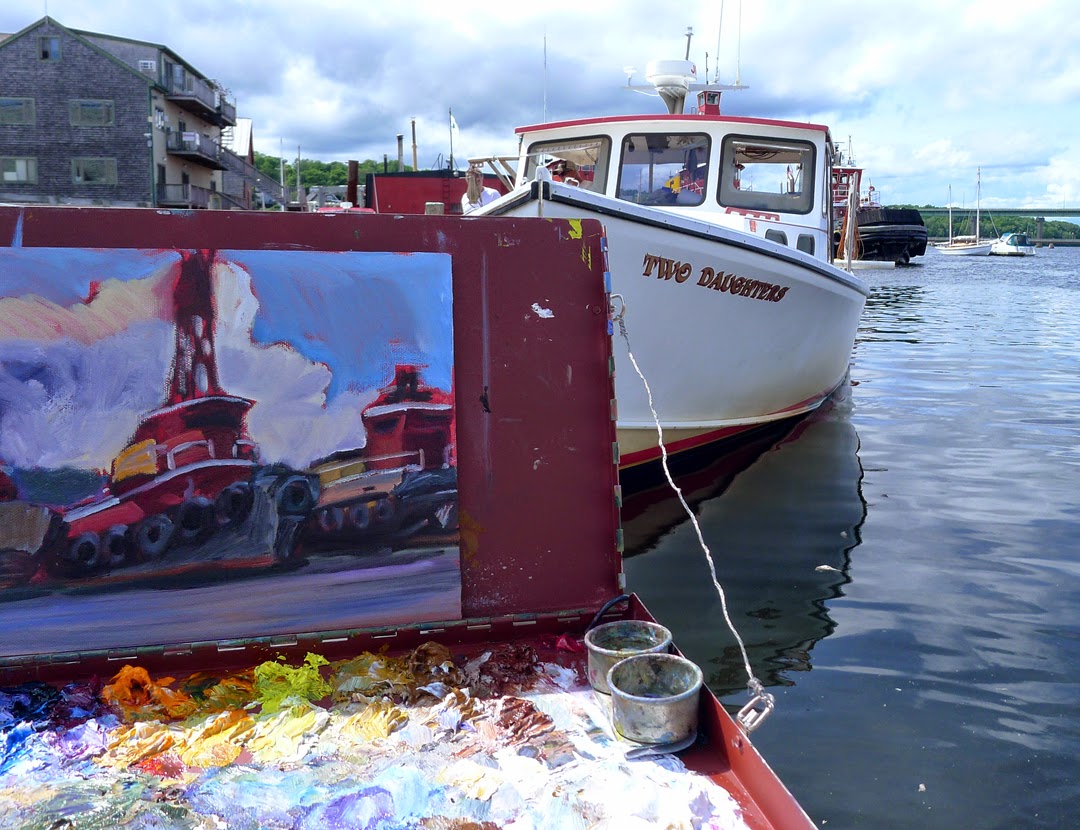Tell me what you want to paint and I’ll tell you where to go.
 |
| Cliff below Owls Head, by Carol L. Douglas, courtesy The Kelpie Gallery. |
This afternoon, I’ll show Poppy Balser around my few miles of Maine coastline. It’s the best fun two artists can have.
Belfast lies at the mouth of the Passagassawakeag River. It is a city only in the organizational sense—it has about 6700 people this time of year. Its boom was in the early 19th century, and its mansions and brick-fronted commercial streets reflect that.
Belfast’s real charm to the painter lies in its exceptional harbor access via Harborwalk, which runs along a working boatyard out to the Armistice footbridge. From there, you can see its iconic red tugboats and look back on the harbor from the water side (courtesy of the footbridge).
 |
| The Three Graces, by Carol L. Douglas, courtesy Camden Falls Gallery. |
Just south of Belfast is Bayside, founded as the Northport Wesleyan Grove Camp Meeting in 1848. At one time, it drew thousands of the faithful to its 30 acres of oceanfront. Today, it’s a sleepy hamlet of historic beachfront cottages, most built between 1870 and 1920. There are no services, no stores, and no stoplights.
Lincolnvilleis low to the ground, a beach fronting its main street, so it has the whiff of more southerly climes. My favorite place to paint here is the mouth of the Ducktrap River, which snakes into Penobscot Bay around a gravel bar.
Poppy will have seen Camden, one of the great summer colonies along the coast. It’s famous for its schooners and pleasure boats. Many of these will be wrapped for the season. But there’s always something to paint in this harbor.
| Rockport Autumn Day, by Carol L. Douglas (private collection) |
I don’t even need to go that far. Rockport’s fishing fleet is clustered in the mouth of our harbor, bounded by beautiful old buildings and a working boatyard. It’s one of the prettiest villages on the Maine coast.
But if Poppy wants to paint trawlers, she’ll have to go south to Rockland’s Municipal Fish Pier. We could paint at the North End Shipyard or the city’s famous lighthouse. Below the Apprentice Shop, there’s a great view of the working harbor. It’s a city famous for its art, from the Farnsworth Art Museumand Center for Maine Contemporary Art to its innumerable commercial galleries. Like Belfast, it has a beautiful downtown.
 |
| American Eagle in Drydock, by Carol L. Douglas, courtesy Camden Falls Gallery. |
The St. George Peninsula, however, is my favorite place to paint in this area. We can start at Owls Head, with its lighthouse and beautiful waterscapes in every direction. There’s a good angle on its fishing fleet from Lighthouse Road. Down the road is South Thomaston. The Weskeag River passes through it, changing character with the tide. From Spruce Head to Port Clyde, this peninsula has some of the best rocky shoreline south of Acadia. We might slip down to Clark Island, or over to Long Cove.
Tenant’s Harbor is a place I haven’t painted enough. It has a lobster pound, a fishing fleet, an inlet and beautiful architecture. Mosquito Harboris lined with low marshes. Then there’s Drift Inn beach, and the Marshall Point Lighthousebefore we get to Port Clyde. This is another famous beauty spot, with a great fishing harbor visible from many angles. It’s also where we catch the ferry to Monhegan.
 |
| Lobster Pound at Tenants Harbor, by Carol L. Douglas, courtesy The Kelpie Gallery. |
That represents slightly more than 40 miles of driving, but it’s enough to keep a painter busy for a lifetime. Consider, then, that the Maine coast is about 5000 miles long. All the landscape painters in America could come here and we’d never fully capture its infinite variety.





















